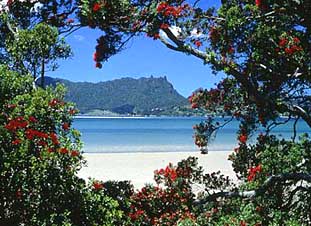|
|
|
|
Small towns and suburban areas have Santa parades where community groups proudly display brightly decorated floats. It is not always hot enough in the early summer to have Christmas dinner on the beach (February is usually the hottest month). Many people in New Zealand follow the old English traditions and have turkey and plum pudding, but these are often served with cold salads. Sometimes the traditional dinner is cooked on the barbecue outside and may include a whole variety of typical Kiwi treats, such as lamb chops, along with the usual Christmas fare. No one would think Christmas complete without a fluffy Pavlova -- an airy meringue confection made of whipped egg whites and sugar, cooked in a slow, low-heated oven and then decorated with fruit, such as kiwifruit and strawberries, and then piled high with whipped cream. Although Australia claims Pavlova for its own, it was created by a "Kiwi" who worked as a chef in Australia. Therefore, this fabulous creation is also claimed by New Zealand.  Because so many people from the Northern hemisphere now live in New Zealand, it has become the tradition to have two Christmases, one on the 25th of December and the other in July, which is mid-winter. Many hotels, restaurants and homes put on the full Christmas celebration, complete with tree, gifts and of course all the foods which were just too heavy to serve in the heat of summer. In many small towns and villages, Santa visits all the children on Christmas morning riding on a fire engine. They hear him coming because the siren warns them to come out of their homes and stand by the road so he can toss candy to them. Many people in New Zealand will create a traditional Maori hangi. This is essentially a big hole in the ground which is heated with hot rocks placed in it. It's filled up with baskets of food, covered and then allowed to cook underground. By the time the food comes out, everyone is anxiously waiting for the tender pork, chicken, kumara, pumpkin, potatoes and stuffing. It's been said that there is nothing to compare with the total bliss of the taste of food from a hangi, delicately smoked and melt-in-the-mouth soft. Usually the hangi is served in the late afternoon or early evening. After the meal, folks often sit around singing carols as it gets dark. |